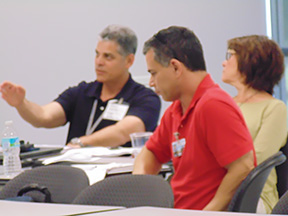By Karen Langbehn
A pilot program — one of only three in the nation — put elected officials, planners and emergency managers in the driver’s seat to create long-range plans for climate change, specifically, adaptation to sea level rise and extreme heat.
Created by the Department of Homeland Security (DHS) sector outreach programs division, the two-day event explored the issues facing Tampa Bay and then moved to an interactive tabletop planning session that gave participants the opportunity to experiment with investing in adaptations to reduce infrastructure vulnerability.
“As a region, we need to be willing to respond and prepare for change,” said Maya Burke, senior environmental planner at the Tampa Bay Regional Planning Council. “Sea level rise is and will continue to be a significant factor affecting the growth and development of our region. But it’s a manageable factor that doesn’t require us to be afraid, feel threatened, or to sacrifice or even abandon what we know and love. In fact, responding to and managing this reality can ensure that we prepare for the best possible future for our region – a resilient, safe and prosperous one.”
Infrastructure – from bridges and highways to power plants and water treatment facilities – was the central focus of both DHS-sponsored events. Although many don’t think about it on a daily basis like they might about individual investments in homes, infrastructure is the key to our region’s commerce, trade, and mobility. If climate and weather events were to affect the functionality of these lifelines, our safety – and security – would become extremely vulnerable.

Regional stakeholders were first asked to identify local impacts from various climate stressors on the transportation, energy, and water sectors and later invited to participate in a game simulating the decision-making process to implement adaptation strategies designed to address the local impacts identified in the earlier session. The tabletop exercise marked the first time DHS tackled the issue of climate hazards and infrastructure resilience through a game.
Participants worked in small groups to use an allotted budget ($15) to choose the facilities that they wanted to protect. For the purpose of the game, assets included 4th Street North, the Gandy Bridge, the Duke Energy Bartow Plant, the St. Petersburg-Clearwater airport, and the Northeast Water Reclamation Facility, but the same process could easily be applied to other places. Each team was charged with keeping the greatest amount of key infrastructure operating given sea level rise scenarios of 1.7 feet and 5.2 feet. The adaptation strategies that players could choose from included options like sandbagging critical pathways and implementing green infrastructure to reduce runoff (e.g., converting impervious surfaces to pervious surfaces or developing zero-discharge parking lots) to more substantial investments, such as modifying the design of and/or raising Gandy Bridge. After negotiating how to allocate their modest budgets across the various adaptation options, the groups reconvened to share their successes – and deliberate about their challenges.
Since all of these assets couldn’t be fully protected within the allotted budget, tradeoffs had to be made. For some groups, this meant that protecting infrastructure like the Gandy Bridge took precedence over protecting the San Martin or Snell Isle bridges. In this scenario, participants deliberated about what residents in these regions may have to do in order to ensure their health and safety, given a major storm event and/or the inundation of their communities.
Other groups decided to invest in “no regrets” strategies, or best management practices, that would amplify the benefit of other adaptive activities.
These didn’t prove to be easy conversations to have – and even more difficult was determining how to carefully but clearly communicate these potential scenarios to residents and decision makers.
A resounding question emerged: Is it possible to plan for sea level rise while still attracting and retaining new and existing residents? What would happen to the regional economy as a result? Many of the participants agreed that although this would be a challenging task, it was their responsibility to do so – but with a few caveats.
Exercise participants agreed that meaningful options for individual citizens’ responses to the potential problems (like insurance discounts for more climate resilient structures) ought to be put in place to encourage communities to be more resilient over time. Focusing on the problems at hand – ones that were experienced locally and frequently – and providing incentives for incremental improvements could provide a means of opening the door to more widespread action and adoption of protective measures that would gradually bolster the resilience of the Tampa Bay area.
Even though they didn’t make any decisions about solutions that day, great strides were made to define our local challenges – an integral first step toward exploring how we want to customize adaptation solutions for our region.
[su_divider]